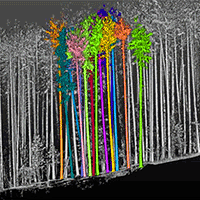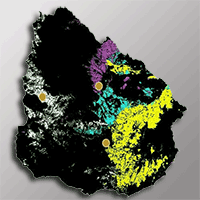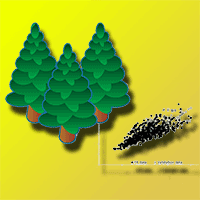
Standing tree assessment for the maintenance of historic wooden buildings: a case study of a World Heritage site in China
iForest - Biogeosciences and Forestry, Volume 6, Issue 4, Pages 169-174 (2013)
doi: https://doi.org/10.3832/ifor0753-006
Published: May 08, 2013 - Copyright © 2013 SISEF
Research Articles
Abstract
Historic wooden buildings are a symbol of China’s “culture of wood” and require extraction of forest resources for their renovation. In the 21st century, natural resources are limited globally, and sustainable solutions are needed. In this study, we established a new method to connect building and forest sites for efficient utilization of limited forest resources for the renovation of historic buildings. We obtained measurements of large wooden components from Shenyang Imperial Palace. We also performed morphometric analyses on 47 thinned, old-growth larch trees to determine the relative taper curve, and selected 108 standing trees for simulation of the tree-height curve in the Mt. Changbai area, Jinlin Province, Northeast China. On the basis of forest metrology, we established an upper tree prediction method. By measuring the diameter at breast height (DBH) alone, we could compare size information (e.g., diameter, length) for standing trees and wooden building components. This method was then applied to estimate the required DBH class of standing trees for the renovation of Shenyang Imperial Palace.
Keywords
Sustainable Renovation, Relative Taper Curve, Tree Height Curve, Standing Tree Assessment, Historic Wooden Buildings
Authors’ Info
Authors’ address
H Yamamoto
Graduate School of Frontier Science, the University of Tokyo, 5-1-5 Kashiwanoha, Kashiwa, 277-8563 Chiba (Japan)
Corresponding author
Paper Info
Citation
Yin W, Yamamoto H (2013). Standing tree assessment for the maintenance of historic wooden buildings: a case study of a World Heritage site in China. iForest 6: 169-174. - doi: 10.3832/ifor0753-006
Academic Editor
Marco Borghetti
Paper history
Received: Aug 29, 2012
Accepted: Mar 07, 2013
First online: May 08, 2013
Publication Date: Aug 01, 2013
Publication Time: 2.07 months
Copyright Information
© SISEF - The Italian Society of Silviculture and Forest Ecology 2013
Open Access
This article is distributed under the terms of the Creative Commons Attribution-Non Commercial 4.0 International (https://creativecommons.org/licenses/by-nc/4.0/), which permits unrestricted use, distribution, and reproduction in any medium, provided you give appropriate credit to the original author(s) and the source, provide a link to the Creative Commons license, and indicate if changes were made.
Web Metrics
Breakdown by View Type
Article Usage
Total Article Views: 53713
(from publication date up to now)
Breakdown by View Type
HTML Page Views: 45501
Abstract Page Views: 2868
PDF Downloads: 3873
Citation/Reference Downloads: 19
XML Downloads: 1452
Web Metrics
Days since publication: 4601
Overall contacts: 53713
Avg. contacts per week: 81.72
Citation Metrics
Article Citations
Article citations are based on data periodically collected from the Clarivate Web of Science web site
(last update: Mar 2025)
Total number of cites (since 2013): 6
Average cites per year: 0.46
Publication Metrics
by Dimensions ©
Articles citing this article
List of the papers citing this article based on CrossRef Cited-by.
References
Natural forest protection: an overview abroad and a review at home. Journal of Beijing Forestry University Social Sciences 3 (2): 50-54. [In Chinese with English abstract]
Gscholar
A study of the types of timber used in the hall of martial valour (wuying dian) group of buildings and matching them. Palace Museum Journal 132 (3): 6-27.
Gscholar
Standards for evaluating taper estimating systems. The Forest Chronicle 69: 438-444.
Gscholar
Compilation on volume table of Larix olgensis plantation in hilly area of Sanjiang Plain. Forest Engineering 26 (5): 1-3.
Gscholar
Forest resources management for the renovation of wooden cultural buildings in Japan-Horyuji temple in Nara Prefecture. In: FORCOM Abstract Proceedings of the “International Symposium on The Role of Forests for Coming Generations”, pp. 92-95.
Gscholar
Research on timber construction in the imperial palace of the Qing Dynasty in Shenyang (1 edn.). Southeast University Press, Nanjing, China. [in Chinese]
Gscholar
Study on evaluating a standing tree used for wooden cultural buildings-about the method to presume size and quality of the timber. Forest Resources and Mathematical Modeling 8:1-12. [in Japanese with English abstract]
Gscholar
Forest resources management to support the Japan’s “Culture of Wood.” Journal of Forest Planning 16: 99-105.
Gscholar
Individual tree height-diameter curves of larch-spruce-fir forests. Forest Research 220: 182-189. [In Chinese with English abstract]
Gscholar

















